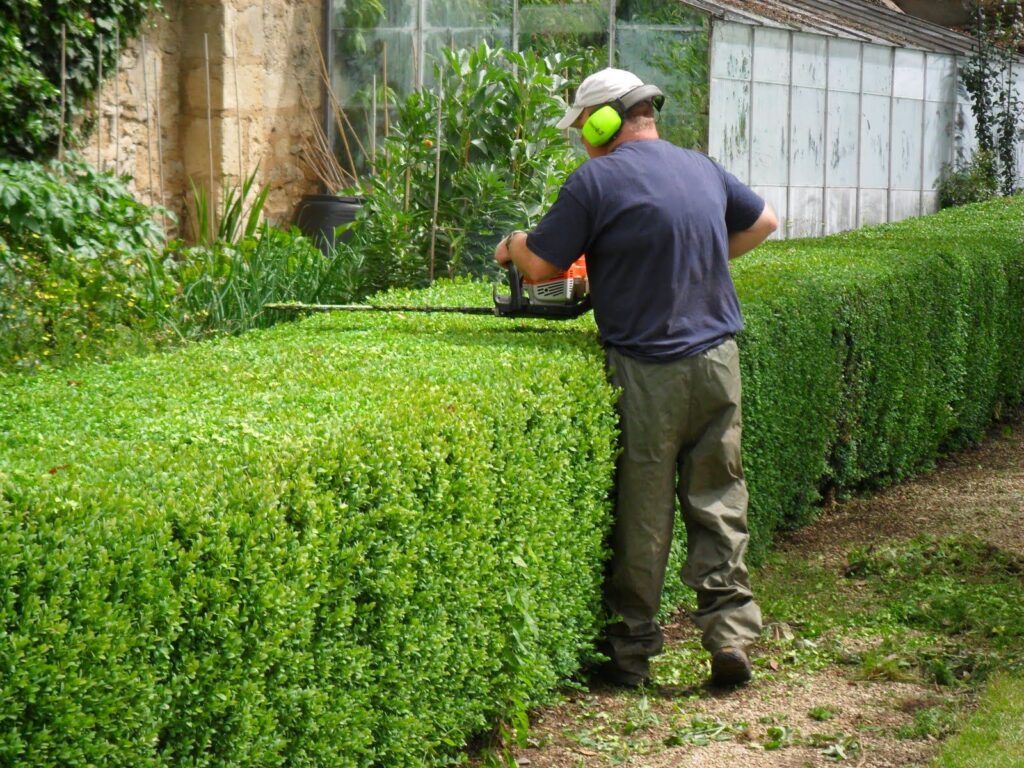Hedge trimming can be an essential part of keeping your garden looking neat and tidy. However, it’s important to understand the cost involved in this task and budget accordingly. In this article, we will explore the basics of hedge trimming, factors that influence the cost, the average cost of professional hedge trimming, and considerations for DIY hedge trimming. By the end of this article, you will be able to make an informed decision about how to allocate your resources for hedge trimming.
Understanding the Basics of Hedge Trimming
Before delving into the cost of hedge trimming aspect, let’s familiarize ourselves with hedge trimming. Simply put, hedge trimming involves shaping and maintaining the boundaries of your hedges. It is done to ensure a clean and presentable appearance, while also promoting healthy growth.
When it comes to hedge trimming, precision is key. The art of hedge trimming dates back centuries, with intricate designs and patterns adorning grand estates and gardens. From simple geometric shapes to elaborate animal figures, skilled gardeners can transform hedges into living works of art.

What is Hedge Trimming?
Hedge trimming refers to the process of selectively trimming individual branches of a hedge to achieve a desired shape and size. It is different from hedge pruning, which involves removing dead or diseased parts of the hedge.
Each hedge species has its own unique growth patterns and requirements for trimming. Some hedges, like boxwoods, respond well to frequent trimming to maintain a dense form, while others, such as yews, benefit from less frequent but more drastic pruning to encourage new growth.
Why is Hedge Trimming Important?
Hedge trimming is important for several reasons. Firstly, it helps maintain the overall aesthetic appeal of your garden by keeping the hedges well-manicured and neat. Additionally, regular trimming promotes healthy growth by allowing sunlight to reach all parts of the hedge, reducing the risk of disease or pest infestation.
Furthermore, well-trimmed hedges can act as natural barriers, providing privacy and security for your property. In historical contexts, hedges were even used as living fences to mark boundaries and protect crops from wind and animals. Today, they continue to serve as green partitions that define outdoor spaces and create a sense of enclosure.
Factors Influencing the Cost of Hedge Trimming
The cost of hedge trimming can vary depending on several factors. Understanding these factors will help you estimate the budget required for this task.
When it comes to hedge trimming, there are additional factors beyond just size and complexity that can influence the overall cost. One such factor is the type of hedge being trimmed. Different species of hedges require different techniques and tools, which can impact the cost of the service. For example, trimming a dense, thorny hedge may take more time and effort compared to a softer, more manageable hedge.
Size and Number of Hedges
The size and number of hedges play a significant role in determining the cost of trimming. Larger hedges or multiple hedges will require more time and effort, resulting in higher costs.
Moreover, the height of the hedges can also affect the cost. Taller hedges may require specialized equipment or additional safety measures, which can add to the overall price of the trimming service. It’s essential to communicate the height of your hedges to the professionals to get an accurate cost estimate.
Complexity of the Job
The complexity of the hedge trimming job can also impact the cost. If your hedges have intricate shapes or require special attention due to underlying structures, such as fences or buildings, the cost may be higher.
Additionally, the accessibility of the hedges plays a crucial role in determining the cost. Hedges that are hard to reach or located in challenging terrain may require more time and effort to trim, leading to a higher price. Factors like narrow pathways or obstacles near the hedges can also affect the overall cost of the trimming service.
Frequency of Trimming
The frequency of hedge trimming is another factor to consider. Regular trimming costs less than a one-time major overhaul. If you maintain a regular trimming schedule, the cost may be more manageable.
Furthermore, the season in which you schedule the hedge trimming can impact the cost. Trimming during peak seasons when landscaping services are in high demand may result in higher prices. Planning your hedge trimming during off-peak times can potentially save you money while still ensuring your hedges are well-maintained.

Average Cost of Professional Hedge Trimming
If you prefer hiring professionals to take care of your hedge trimming, it’s essential to have an idea of the average cost involved. This will help you budget accordingly and determine if professional services align with your financial plans.
Professional hedge trimming services not only save you time and effort but also ensure that your hedges are maintained properly, promoting healthy growth and an aesthetically pleasing landscape. By investing in professional hedge trimming, you are also investing in the overall curb appeal and value of your property.
Hourly Rates vs Flat Rates
Professional hedge trimmers may charge either an hourly rate or a flat rate for their services. Hourly rates usually range from $40 to $75, while flat rates can vary depending on the size of the hedges, starting from $150 onwards. Make sure to discuss the pricing structure with the professionals before finalizing any agreements.
Hourly rates are beneficial for smaller hedge trimming jobs that require less time, while flat rates are more suitable for larger projects that may take several hours to complete. Consider the size and complexity of your hedge trimming needs when deciding between hourly and flat rates.
Additional Costs to Consider
Keep in mind that additional costs may apply. If the hedge trimmers need to remove the cut branches or dispose of the green waste, there might be an additional fee. It’s best to clarify these details in advance to avoid any surprises.
Furthermore, some professional hedge trimming services may offer additional perks such as shaping the hedges into intricate designs or providing advice on hedge maintenance and care. These value-added services can enhance the overall experience and results of hiring professionals for your hedge trimming needs.
DIY Hedge Trimming: Cost and Considerations
If you prefer the satisfaction of doing it yourself, hedge trimming is an option worth considering. However, there are some cost implications and considerations to keep in mind.
When embarking on the journey of DIY hedge trimming, it’s crucial to understand the intricacies involved in maintaining the health and aesthetics of your hedges. Beyond just a simple trim, proper hedge care involves knowledge of different hedge species, growth patterns, and seasonal pruning requirements. By educating yourself on these aspects, you can ensure that your hedge trimming efforts yield not only a visually appealing result but also promote the overall well-being of your plants.
Necessary Equipment and Tools
DIY hedge trimming requires proper equipment and tools. You will need a hedge trimmer, pruning shears, safety goggles, and gloves. Investing in good-quality tools will ensure efficiency and safety throughout the process. Depending on the quality and brand, these tools can cost anywhere from $50 to $200.
Moreover, beyond the initial investment in tools, it’s essential to consider the maintenance and upkeep costs associated with keeping your equipment in top condition. Regular sharpening of blades, cleaning of trimmers, and proper storage can prolong the lifespan of your tools and ensure they remain effective for future hedge trimming sessions.
Time Investment and Skills Required
DIY hedge trimming also requires a significant time investment. Depending on the size and number of hedges, it can take several hours or even days to complete the task. Additionally, it’s essential to have the necessary skills to trim hedges properly. Improper trimming techniques can harm the hedges and result in costly repairs or replacements.
Developing proficiency in hedge trimming techniques takes practice and patience. Understanding how to create clean cuts, shape hedges symmetrically, and promote healthy growth are all essential skills for any DIY enthusiast looking to take on this task. By honing these abilities, you can elevate your hedge trimming from a basic chore to a form of art that enhances the beauty of your outdoor space.

Budgeting for Your Garden’s Needs
Now that you have an understanding of the factors that influence the cost of hedge trimming and the average costs associated with professional services as well as DIY, let’s focus on budgeting for your garden’s needs.
Planning Your Garden Maintenance Budget
When creating your garden maintenance budget, consider the frequency of hedge trimming, other essential tasks like lawn care or irrigation, and any ongoing maintenance costs. Allocating a specific portion of your budget to hedge trimming will ensure that you can maintain your hedges without straining your finances.
However, it’s important to note that budgeting for your garden’s needs goes beyond just hedge trimming. You should also consider the cost of purchasing new plants or seeds, fertilizers, and other gardening tools. These expenses can add up quickly, so it’s essential to factor them into your budget to avoid any surprises.
Saving Money on Hedge Trimming
If you’re looking to save money on hedge trimming, there are a few tips worth considering. First, try to maintain a regular trimming schedule. By trimming the hedges before they become overgrown, the task becomes easier and less time-consuming, resulting in cost savings.
Another way to save money is by exploring the option of DIY hedge trimming. While hiring professionals can provide convenience and expertise, doing it yourself can significantly reduce costs. Just make sure to invest in quality hedge trimmers and follow proper safety precautions.
Additionally, you can explore options for recycling or reusing the green waste produced during trimming to avoid additional disposal fees. Consider using the clippings as mulch for your garden beds or composting them to enrich your soil. Not only will this save you money, but it’s also an eco-friendly approach to garden maintenance.
In conclusion, hedge trimming is an important aspect of garden maintenance. By understanding the basics of hedge trimming, the factors influencing the cost, the average cost of professional services, and considerations for DIY, you can make an informed decision about how to budget for your garden’s needs. Whether you decide to hire professionals or tackle the task yourself, proper budgeting will ensure that your garden remains beautiful and well-maintained without breaking the bank.
